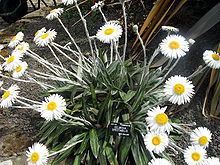Higher classification Celmisia | Scientific name Celmisia spectabilis Rank Species | |
 | ||
Similar Celmisia, Daisy family, Asterales, Aciphylla aurea, Aciphylla | ||
Celmisia spectabilis eggleston silver
Celmisia spectabilis is one of the more widespread species in the mountainous areas of New Zealand, where it is commonly known as the cotton daisy. Belonging to the Asteraceae family, the leathery leaves of this species are ovate (egg-shaped) to lanceolate (narrow and tapering to a point) or narrowly oblong, and can reach 30 cm long. They have a shiny, green upper surface, with prominent parallel grooves but their undersides are densely covered in soft, whitish or buff-coloured hairs. The leaf bases overlap and compact to form a stout pseudostem (false stem). Plants can form mats up to 2m across.
Contents
The flower stems reach 30cm tall and are densely covered with white hairs. A beautiful solitary flower head, 3–5cm across, is borne at the end of each stem. The flower head consists of two types of florets: the ‘ray florets’ at the margins and the ‘disc florets’ in the centre. In Celmisia spectabilis, the numerous ray florets are white and the disc florets yellow.
History
Joseph Hooker described it in 1844, in the first volume of his Flora Antarctica. The specimens he studied were collected by the English botanist John Bidwill in 1839 on Mt Tongariro, on New Zealand’s North Island.
